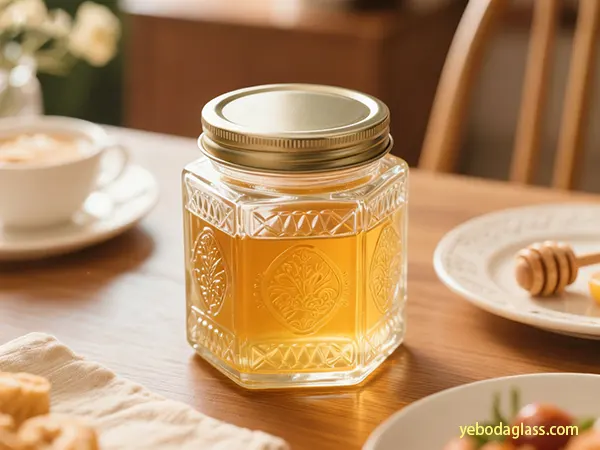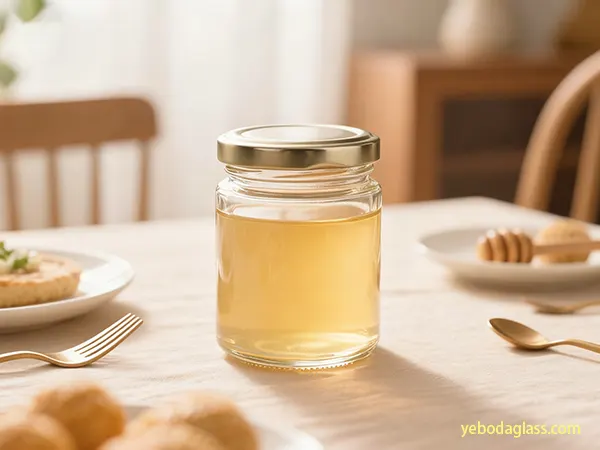Executive Summary
The 2026 honey jar wholesale market is undergoing a significant change period after a couple of years of stagnation, due to a combination of consumer preference changes, sustainability stricter demands, and an increase in complexity of supply chains. This document helps to comprehend deeply these changes by thoroughly analyzing the trends, the market phenomena, and offering practical strategies to the firms of the relevant industry that produce or sell the products to the retailers. The demand for natural and organic honey is the main factor conditioning the behavior of buyers, and thus, the consumers of honey are more inclined to purchase eco-friendly, lightweight glass packaging which is compatible with their sustainable living values. The supply chains that are transparent and durable are, thus, the main sources of competitive advantage, whereas the unstable expenses that result from climate, energy, and geopolitical factors will be the main challenges to the industry stability in the future. In order to keep their market share, honey jar wholesale suppliers are to implement agile sourcing models, commit themselves to packaging innovation, and their measurable sustainability goals shall be integrated into every stage of production. By contrast to the other manufacturer, Yeboda has kept its place in this pattern with its premium glass honey jars that are renounced for their transparency, rigidity, and customization. The production process of Yeboda is not only about high precision mold and use of eco-friendly materials, but also about a more efficient logistics system, which is a cost-lowering strategy for partners while product quality and visual appeal are at the highest level. Yeboda’s knowledge will enable brands to unite the two – aesthetics and functionality – which, at the same time, is a solution to the problem of environmental degradation, thus providing them with longevity in the honey jar wholesale market that is constantly changing.

Research Scope and Parameters
Here we have a framework for the honey jar wholesale market study, which considers the main honey-producing and honey-consuming regions on the globe, namely North America, Europe, Asia-Pacific, and certain emerging markets. These areas are very closely connected through the flows of global trade in honey and packaging.
Honey Varietal and Certification Analysis
In the first place, this paper deals with the most significant and most probable future contributors of the honey market such as Acacia, Clover, Manuka, Wildflower, Orange Blossom, and Buckwheat. At the same time, the report highlights several certifications and among them the most significant are: USDA Organic, EU Organic, Fair Trade, Non-GMO Project Verified, and Kosher. All these certifications are important markers of quality and source ethics in the honey jar wholesale distribution channel.
Jar Specifications and Packaging Materials
Some of the major jar features that can be researched in the glass honey jar wholesale domain are:
- Materials: Main focuses are glass jars and PET (glass bottles alternatives) with increased usage of PCR and recycled content.
- Sizes: Various retail-ready containers such as 8 oz, 12 oz, 16 oz, and 24 oz alongside industrial bulk containers.
- Closures: Metal lug caps, tamper-evident seals, and environmentally friendly single-material closures.
The totality of this set mirrors food manufacturers’ changing requirements while they seek reliable honey jar wholesale partners.
2026 Global and Regional Market Landscape for Honey Jar Wholesale
The worldwide honey jar wholesale market is expected to be on an upward trend throughout 2026 with the total honey-related wholesale value estimated to be between $9 and $10 billion. The major factors contributing to such growth will be the spread of the glass jar use among health-conscious consumers, innovative means of promoting the use of glass jars, and the increasing use of sustainable packaging.
Global Market Dynamics
- Supply Pressures: The result of climate change, colony collapse disorder, and pesticide exposure, have been honey supply disruptions for a long time.
- Demand Resilience: Thanks to the consumer demand for natural and unprocessed sweeteners that honey is now fully integrated into food production.
- Trade Regulations: New import standards dealing with authenticity and origin tracing have a significant impact on honey jar wholesale supply chains.
Regional Market Insights
- North America: With the notable trend of health, bakery, and beverage industry to adopt products, the demand for honey is soaring, plus an increasing number of glass honey jars are made of the recycled content.
- Europe: An advanced market that largely concentrates on clear origin and circular economy packaging.
- Asia-Pacific: The area is experiencing the most significant growth rate mainly because of urbanization, increasing incomes, and the rising demand for e-commerce packaging.
- South America: The honey producing areas of the world, like Argentina and Brazil, are the biggest exporters of honey jars for the wholesale market.
- Africa: A new supplier base with a wide range of offerings and possibilities for the organic honey sector to grow.
Demand Drivers and Application Trends by Food Manufacturing Segment
Food manufacturers combine bulk honey jars and bulk honey supplies to meet consumer demands for health, authenticity and sustainability.
Bakery and Confectionery
Honey is among the clean-label favorites; Being a naturally sweet product, it is the most suitable source of sugar in bakery and confectionery products.
- Products: Granola bars, pastries, chocolate and caramel glazes.
- Jar Trends: Larger jars are for industrial use, and smaller glass jars are for luxury spreads.

Sauces, Dressings and Beverages
- Drivers: Using honey in sauces and drinks is a wise decision because, apart from being a sweetener, honey also has emulsifying and preservative properties in the product.
- Applications: Salad dressings, craft teas and meads.
- Jar Trends: Glass jars filled with honey are a very cool and elegant packaging solution for premium products.
Dairy, private label and health products
- Drivers: Demand for clean, natural sweeteners in yogurt, desserts and dietary supplements.
- Applications: Honey yogurt topping, functional drinks and raw honey blends.
- Jar Trends: Lightweight glass honey jars are used for the production of premium products.
- Jar Trends: Premium products are made from lightweight glass honey jars.
Honey Varietal, Certification, and Processing Trends
Varietal Preferences
Consumer sophistication is driving demand for varietal diversity within the honey jar wholesale segment:
- Clover/Wildflower: Remain dominant for versatility.
- Acacia/Orange Blossom: Favored for light color and clarity.
- Manuka: Premium varietal with medical-grade value.
- Buckwheat: Rising for its robust, dark profile.
Certification and Traceability
Organic, Fair Trade, and Non-GMO certifications are essential to secure trust in global honey jar wholesale operations. Increasingly, manufacturers demand traceable supply chains and authentication testing to prevent adulteration.
Processing Innovation
Demand for raw honey and minimally processed products continues to expand, supporting premium branding and cleaner ingredient labeling across glass honey jar wholesale packaging lines.

Wholesale Jar Material, Size, and Closure Innovations
Material Evolution
Glass jars remain the benchmark for honey packaging:
- Advantages: Recyclable, inert, and premium-looking.
- Innovations: Lightweight, custom-molded glass bottles with higher PCR glass content.
PET jars are gaining ground for cost efficiency and transportation advantages. However, the market’s sustainability push keeps glass honey jars in strong demand for honey jar wholesale contracts.
Specific Capacities and Closure Technologies
- Standard Retail Sizes: 8 oz, 12 oz, 16 oz, 24 oz are the main sellers that have been kept.
- Closures: Metal lug caps, plastic screw caps, and tamper-evident seals attract product integrity and shelf life.
Supply Chain Dynamics and Logistics
Supply Chain Efficiency
Honey and glass jars for the world market are affected by a variety of factors such as tensions in the geopolitical arena, congestion at the ports, and the cost of transportation. Thus, manufacturers must have robust logistics systems that are not only capable of real-time tracking but also have regional diversification.
Volume and Sourcing Strategies
- Direct vs. Broker Sourcing: The direct sourcing provides more transparency and better control of expenses.
- Long-Term Contracts: These are crucial for maintaining the price level.
- Regional Diversification: Shortens lead times for glass honey jar wholesale operations and increases the flexibility of the business.
Logistics Optimization
By using multimodal transport (sea, rail, truck) and also by applying demand forecasting that is predictive, a company can significantly cut down on freight inefficiencies and at the same time have a continuous honey jar wholesale supply.
Pricing Forecasts and Cost Structure Analysis
Honey Pricing Outlook
Rising energy costs, beekeeping expenses, and climate disruptions will drive up raw honey prices by an estimated 5–15% in 2026. Specialty varietals like Manuka and Organic will sustain premium pricing within honey jar wholesale portfolios.
Jar Pricing Forecasts
- Glass Jars: Moderate increases (3–8%) due to energy costs and higher PCR content demand.
- PET Jars: Slightly higher fluctuations (4–10%) linked to resin and rPET market volatility.
- Logistics: Remains a core factor affecting total cost of ownership for glass honey jar wholesale buyers.
Strategic Recommendations and Future Outlook
Strategic Recommendations
How to keep a strong position in the bulk honey jar business if you are a manufacturer?
- Firstly, you should not rely on one supplier, but you should have multiple suppliers from different regions.
- Secondly, you need to put your money in the development of clean and ecological glass jars and glass bottles for honey packaging.
- Thirdly, you have to cooperate with suppliers who are already certified for a relatively long time.
- Fourth, companies should implement digital traceability solutions to provide a clear view of the value chain to all stakeholders.

Future Market Trends
The bulk honey jar business will be very profitable in 2026 for those who manage to maintain a good balance between sustainability, supply chain resilience, and the innovation of high-end packaging. As requirements from regulators and consumers change, glass honey jars will be the leading standard in packaging – a package that stands for purity, quality, and giving back to the planet.




